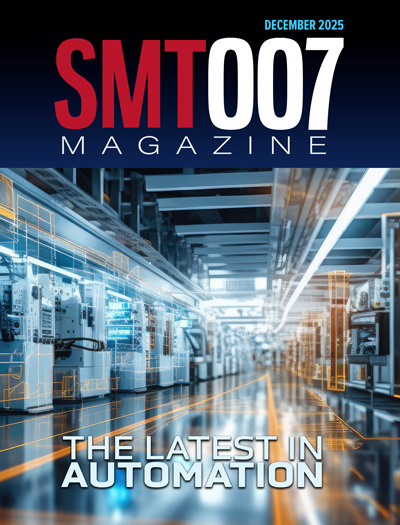-

- News
- Books
Featured Books
- smt007 Magazine
Latest Issues
Current Issue
The Latest in Automation
When customer requirements shift, responses range from new equipment to automation. Explore the newest solutions reshaping production and how today’s market dynamics are driving these trends.

Spotlight on Mexico
Mexico isn’t just part of the electronics manufacturing conversation—it’s leading it. From growing investments to cross-border collaborations, Mexico is fast becoming the center of electronics in North America. This issue includes bilingual content, with all feature articles available in both English and Spanish.

Production Software Integration
EMS companies need advanced software systems to thrive and compete. But these systems require significant effort to integrate and deploy. What is the reality, and how can we make it easier for everyone?
- Articles
- Columns
- Links
- Media kit
||| MENU - smt007 Magazine
Continuous Improvement in Electronics Manufacturing
February 3, 2017 | James Wykes, JJS ManufacturingEstimated reading time: 4 minutes
The unfortunate reality is that most, if not all, electronics manufacturing companies incur waste in the form of inefficient processes. However, without the desire to continuously improve, this waste can lead to a business becoming uncompetitive or their reputation damaged – both of which can lead to a loss of customers.
So, in order to succeed, all employees within a company must be operationally efficient and work towards a common goal of reducing waste.
With so many variables and "opportunities" to create waste, electronics manufacturing services (EMS) companies have an on-going challenge to identify, address and then eliminate inefficient processes. This is where a continuous improvement approach can help.
So, if you have ever wondered how an EMS provider manages this process and what the approach translates to on a practical, day-by-day basis, read on.
Data Collection
In order to identify areas for improvement, it is critical that the EMS provider has systems and procedures to collect accurate data. In an electronics manufacturing environment, there are multiple sources to collect data, including:
- Internal databases used to record incoming material quality issues
- Surface mount assembly and automated optical inspection (AOI) equipment
- New Product Introduction (NPI) reports
- Route/job cards out on the shop floor
- Test reports
- Internal process improvement schemes
The type of data can also vary greatly. For example, labor time fluctuations may be recorded against the route/ job card, whereas the number of defects may be captured within the automated assembly equipment software.
Data Analysis
Lean and Six Sigma tools are then used to analyse the data, in order to monitor performance, identify any spikes/ trends and help narrow potential root causes. With so much data available it's important that the EMS provider has a process internally to help prioritize their efforts. An effective way to do so is for the continuous improvement engineer to hold a monthly meeting with other stakeholders, so that agreement is reached on which projects should be worked on.
Project Implementation
In an ideal world, every project that is implemented would be able to demonstrate a clear return on investment (ROI). This is particularly true where investment in new equipment, tools or training are required. However, where "quick fixes" can be made, which clearly eliminate waste, a pragmatic approach by the EMS provider may be taken.
For example, if, via the in-house process improvement scheme, a staff member suggests moving packaging materials closer to the dispatch department does a ROI calculation really need to be made? Maybe it does, maybe this was an area crippling the rest of the business resulting in failed customer shipments. Or perhaps it will save the dispatch team a few minutes at the beginning of each day. There's not really a right or wrong answer here, except that common sense should prevail.
Project Management
It's likely the continuous improvement engineer will be working on a number of projects at any one time. To keep track of each project at a top level they will record these into some form of project tracker. The specific details of each project will then be recorded separately within a document, following the DMAIC (define, measure, analyze, improve, control) methodology.
Improvement Feedback
It's critical that there is a formal process for delivering feedback, not only to the business as a whole but to those individuals that have taken the time to input suggestions and ideas. The quickest way to kill any process improvement scheme dead in its tracks is failure to communicate progress. Ideally, this should be provided back to departments and individuals on a monthly basis. This installs confidence in the overall process and helps grow a culture of continuous improvement. In order to help staff members across the business relate to what is/ isn’t being worked on, the EMS provider may share the "Top 10" projects that have realized tangible results. Unfortunately, it's easy for individuals to dismiss process improvements, particularly within their own areas, so the EMS provider will need a system to inspire and invigorate suggestions.
Improving Improvement
If senior management do not support and encourage a continuous improvement approach, then it will be difficult for projects to move forward. A successful approach takes time and dedication, which, of course, comes at a cost. If the senior management don't really see value, or believe it's a box they can tick once a year, the rest of the company will follow suit.
Senior managers within proactive EMS providers will, however, hold quarterly meetings to discuss improvement projects and will be keen to understand how they are progressing. They will also be challenging the in-house team on how to improve the improvement process and continue to involve more and more staff.
Training
On-going education and training for all staff is essential in creating a successful continuous improvement scheme. The continuous improvement engineer within the EMS provider will be expected to lead in this area and develop training programs designed to teach employees about waste and how to implement a DMAIC project, utilizing Lean and Six Sigma tools. Following these training sessions, attendees will be encouraged to identify their own improvement projects and take ownership in seeing these through.
Hopefully, this short article has helped demonstrate how EMS providers can, and should be, approaching continuous improvement. As a customer, you may not always be party to the finding or the solutions that are put in place as many improvements are likely to relate to internal processes. However, if you are interested in finding out more about example projects, or the finer details of the program, we recommend getting in touch with the quality representative within the EMS provider so they can explain some more.
This post originally appeared on the JJS Manufacturing blog, which can be found here.
Testimonial
"Your magazines are a great platform for people to exchange knowledge. Thank you for the work that you do."
Simon Khesin - Schmoll MaschinenSuggested Items
Global Electronics Association Releases Q4 Standards and Revisions Update
12/24/2025 | Global Electronics AssociationEach quarter, the Global Electronics Association releases a list of standards that are new or have been updated. To view a complete list of newly published standards and standards revisions, translations, proposed standards for ballot, final drafts for industry review, working drafts, and project approvals, visit electronics.org/ipc-standards. These are the latest releases for Q4 2025.
Connect the Dots: The Future of Designing for Reality—Outer Layer Imaging
12/24/2025 | Matt Stevenson -- Column: Connect the DotsIf you read my column regularly, you know I’m passionate about helping designers get the most from their designs. In my November column, I focused on designer best practices for the electroless copper component of the manufacturing process. The next step is outer layer imaging: the transition from digital to physical, and where the designer’s IP meets the board.
Accelerating Vehicle Electrification and Intelligence to Drive Automotive Semiconductor Market to Nearly $100B by 2029
12/18/2025 | TrendForceTrendForce’s latest investigations indicate that the rapid acceleration of vehicle electrification and intelligence is expected to propel the global automotive semiconductor market from approximately US$67.7 billion in 2024 to nearly $96.9 billion by 2029, representing a CAGR of 7.4% over the 2024–2029 period.
Rethinking Soldering for Energy-efficient PCB Design
12/17/2025 | Daniele Perico, MacDermid Alpha Electronics SolutionsAs automotive OEMs intensify their commitments to carbon neutrality, ranging from Stellantis’ 20381 net-zero target to BYD’s full value chain neutrality by 20452, they are also embracing circularity through material reuse, recycling, and closed-loop systems. This aligns with the sustainability challenges faced in electronics manufacturing, where energy-intensive processes contribute significantly to industrial CO₂ emissions. By integrating advanced materials and process innovations, both sectors are converging on a shared goal: reducing carbon footprints while enhancing reliability and operational efficiency.
Fresh PCB Concepts: Choosing Via Types—A Practical Guide for PCB Engineers
12/18/2025 | Team NCAB -- Column: Fresh PCB ConceptsWhen you first learn PCB routing, vias look like plumbing: holes that let signals pass between layers. As designs become denser and products shrink, vias develop from simple interconnects into deliberate engineering choices. Selecting between through-hole, blind, buried, microvia, or advanced options like skip vias is a balancing act between electrical performance, manufacturability, cost, and long-term reliability. In HDI boards, via strategy is as consequential as the stackup, material selection, or component placement.


